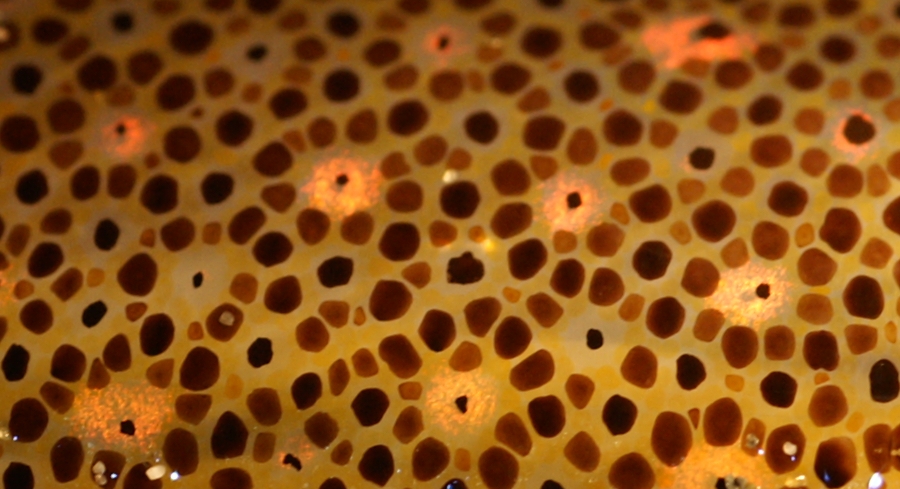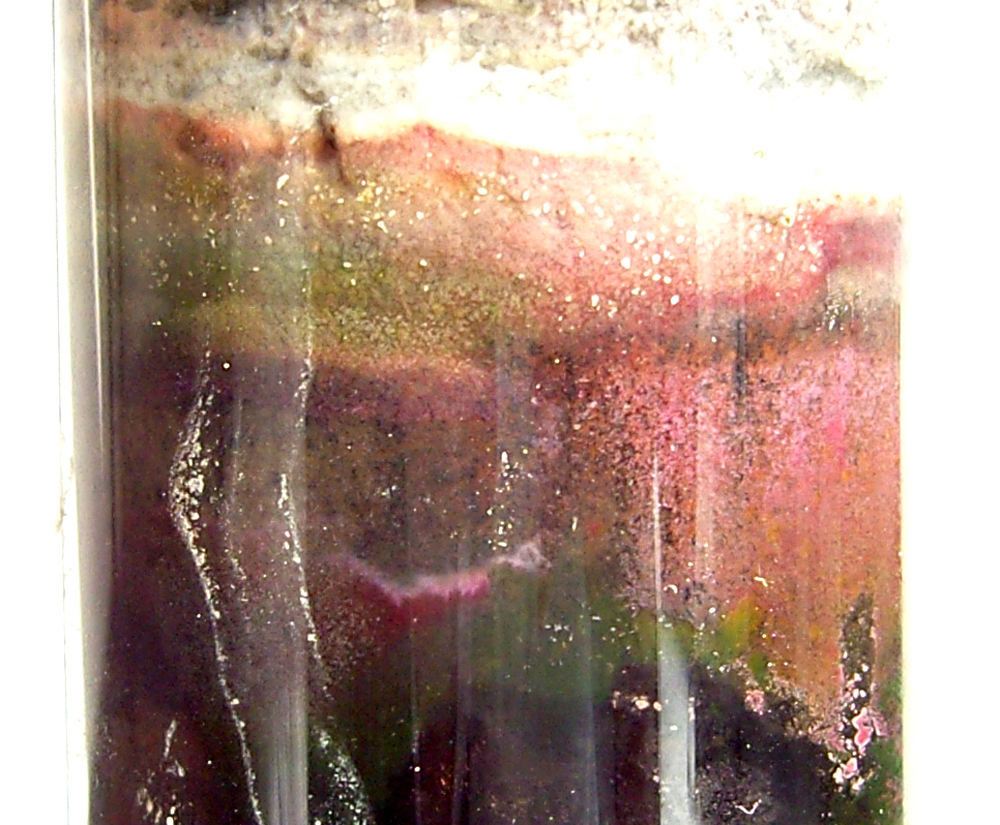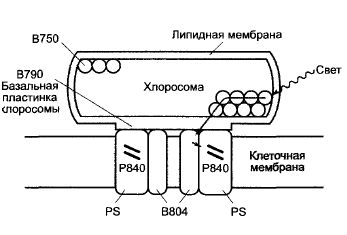|
Chromatophore (bacteria)
In some forms of phototroph, photosynthetic bacteria, a chromatophore is a pigmented(coloured), membrane-associated Vesicle (biology and chemistry), vesicle used to perform photosynthesis. They contain different coloured pigments. Chromatophores contain bacteriochlorophyll pigments and carotenoids. In purple bacteria, such as ''Rhodospirillum rubrum'', the light-harvesting proteins are intrinsic to the chromatophore membranes. However, in green sulfur bacteria, they are arranged in specialised antenna complexes called chlorosomes. References {{reflist Photosynthesis Organelles ... [...More Info...] [...Related Items...] OR: [Wikipedia] [Google] [Baidu] |
Chromatophore
Chromatophores are cells that produce color, of which many types are Biological pigment, pigment-containing cells, or groups of cells, found in a wide range of animals including amphibians, fish, reptiles, crustaceans and cephalopods. Mammals and birds, in contrast, have a class of cells called melanocytes for animal coloration, coloration. Chromatophores are largely responsible for generating skin and eye color, eye colour in ectothermic animals and are generated in the neural crest during embryonic development. Mature chromatophores are grouped into subclasses based on their colour (more properly "hue") under white light: xanthophores (yellow), erythrophores (red), iridophores (reflective / iridescence, iridescent), leucophores (white), melanophores (black/brown), and cyanophores (blue). While most chromatophores contain pigments that absorb specific wavelengths of light, the color of leucophores and iridophores is produced by their respective scattering and optical interference ... [...More Info...] [...Related Items...] OR: [Wikipedia] [Google] [Baidu] |
Phototroph
Phototrophs () are organisms that carry out photon capture to produce complex organic compounds (e.g. carbohydrates) and acquire energy. They use the energy from light to carry out various cellular metabolic processes. It is a common misconception that phototrophs are obligatorily photosynthetic. Many, but not all, phototrophs often photosynthesize: they anabolically convert carbon dioxide into organic material to be utilized structurally, functionally, or as a source for later catabolic processes (e.g. in the form of starches, sugars and fats). All phototrophs either use electron transport chains or direct proton pumping to establish an electrochemical gradient which is utilized by ATP synthase, to provide the molecular energy currency for the cell. Phototrophs can be either autotrophs or heterotrophs. If their electron and hydrogen donors are inorganic compounds (e.g. , as in some purple sulfur bacteria, or , as in some green sulfur bacteria) they can be also called lithot ... [...More Info...] [...Related Items...] OR: [Wikipedia] [Google] [Baidu] |
Vesicle (biology And Chemistry)
In cell biology, a vesicle is a structure within or outside a cell, consisting of liquid or cytoplasm enclosed by a lipid bilayer. Vesicles form naturally during the processes of secretion (exocytosis), uptake ( endocytosis) and transport of materials within the plasma membrane. Alternatively, they may be prepared artificially, in which case they are called liposomes (not to be confused with lysosomes). If there is only one phospholipid bilayer, the vesicles are called ''unilamellar liposomes''; otherwise they are called ''multilamellar liposomes''. The membrane enclosing the vesicle is also a lamellar phase, similar to that of the plasma membrane, and intracellular vesicles can fuse with the plasma membrane to release their contents outside the cell. Vesicles can also fuse with other organelles within the cell. A vesicle released from the cell is known as an extracellular vesicle. Vesicles perform a variety of functions. Because it is separated from the cytosol, the inside of t ... [...More Info...] [...Related Items...] OR: [Wikipedia] [Google] [Baidu] |
Bacteriochlorophyll
Bacteriochlorophylls (BChl) are photosynthetic pigments that occur in various phototrophic bacteria. They were discovered by C. B. van Niel in 1932. They are related to chlorophylls, which are the primary pigments in plants, algae, and cyanobacteria. Organisms that contain bacteriochlorophyll conduct photosynthesis to sustain their energy requirements, but do not produce oxygen as a byproduct. They use wavelengths of light not absorbed by plants or cyanobacteria. Replacement of with protons gives bacteriophaeophytin (BPh), the phaeophytin form. BacterioChlorophyll a.svg, bacteriochlorophyll ''a'' BacterioChlorophyll b.svg, bacteriochlorophyll ''b'' BacterioChlorophyll c.svg, bacteriochlorophyll ''c'' BacterioChlorophyll d.svg, bacteriochlorophyll ''d'' BacterioChlorophyll e.svg, bacteriochlorophyll ''e'' Bacteriochlorophyll f.svg, bacteriochlorophyll ''f'' BacterioChlorophyll g.svg, bacteriochlorophyll ''g'' Structure Bacteriochlorophylls ''a'', ''b'', and ''g'' are b ... [...More Info...] [...Related Items...] OR: [Wikipedia] [Google] [Baidu] |
Purple Bacteria
Purple bacteria or purple photosynthetic bacteria are Gram-negative proteobacteria that are phototrophic, capable of producing their own food via photosynthesis. They are pigmented with bacteriochlorophyll ''a'' or ''b'', together with various carotenoids, which give them colours ranging between purple, red, brown, and orange. They may be divided into two groups – purple sulfur bacteria ( Chromatiales, in part) and purple non-sulfur bacteria ( Rhodospirillaceae). Purple bacteria are anoxygenic phototrophs widely spread in nature, but especially in aquatic environments, where there are anoxic conditions that favor the synthesis of their pigments. Taxonomy Purple bacteria belong to phylum of ''Pseudomonadota''. This phylum was established by Carl Woese in 1987 calling it "purple bacteria and their relatives" even if this is not appropriate because most of them are not purple or photosynthetic. Purple bacteria are distributed between 3 classes:''Alphaproteobacteria'', ''Betap ... [...More Info...] [...Related Items...] OR: [Wikipedia] [Google] [Baidu] |
Rhodospirillum Rubrum
''Rhodospirillum rubrum'' (''R. rubrum'') is a Gram-negative, pink-coloured bacterium, with a size of 800 to 1000 nanometers. It is a facultative anaerobe, thus capable of using oxygen for aerobic respiration under aerobic conditions, or an alternative terminal electron acceptor for anaerobic respiration under anaerobic conditions. Alternative terminal electron acceptors for ''R. rubrum'' include dimethyl sulfoxide or trimethylamine oxide. Under aerobic growth photosynthesis is genetically suppressed and ''R. rubrum'' is then colorless. After the exhaustion of oxygen, ''R. rubrum'' immediately starts the production of photosynthesis apparatus including membrane proteins, bacteriochlorophylls and carotenoids, i.e. the bacterium becomes photosynthesis active. The repression mechanism for the photosynthesis is poorly understood. The photosynthesis of ''R. rubrum'' differs from that of plants as it possesses not chlorophyll a, but bacteriochlorophylls. While bacteriochlorophyll can ... [...More Info...] [...Related Items...] OR: [Wikipedia] [Google] [Baidu] |
Green Sulfur Bacteria
The green sulfur bacteria are a phylum of obligately anaerobic photoautotrophic bacteria that metabolize sulfur. Green sulfur bacteria are nonmotile (except ''Chloroherpeton thalassium'', which may glide) and capable of anoxygenic photosynthesis. They live in anaerobic aquatic environments. In contrast to plants, green sulfur bacteria mainly use sulfide ions as electron donors. They are autotrophs that utilize the reverse tricarboxylic acid cycle to perform carbon fixation. They are also mixotrophs and reduce nitrogen. Characteristics Green sulfur bacteria are gram-negative rod or spherical shaped bacteria. Some types of green sulfur bacteria have gas vacuoles that allow for movement. They are photolithoautotrophs, and use light energy and reduced sulfur compounds as the electron source. Electron donors include H2, H2S, S. The major photosynthetic pigment in these bacteria is Bacteriochlorophylls ''c'' or ''d'' in green species and ''e'' in brown species, and is located in t ... [...More Info...] [...Related Items...] OR: [Wikipedia] [Google] [Baidu] |
Antenna Complex
The light-harvesting complex (or antenna complex; LH or LHC) is an array of protein and chlorophyll molecules embedded in the thylakoid membrane of plants and cyanobacteria, which transfer light energy to one chlorophyll ''a'' molecule at the Photosynthetic reaction centre, reaction center of a photosystem. The photosynthetic pigment, antenna pigments are predominantly chlorophyll b, chlorophyll ''b'', xanthophylls, and carotenes. Chlorophyll a, Chlorophyll ''a'' is known as the core pigment. Their absorption spectra are non-overlapping and broaden the range of light that can be absorbed in photosynthesis. The carotenoids have another role as an antioxidant to prevent photo-oxidative damage of chlorophyll molecules. Each antenna complex has between 250 and 400 pigment molecules and the energy they absorb is shuttled by resonance energy transfer to a specialized chlorophyll-protein complex known as the Photosynthetic reaction centre, reaction center of each photosystem. The reaction ... [...More Info...] [...Related Items...] OR: [Wikipedia] [Google] [Baidu] |
Chlorosome
A chlorosome is a photosynthetic antenna complex found in green sulfur bacteria (GSB) and some green filamentous anoxygenic phototrophs (FAP) ( Chloroflexaceae, Oscillochloridaceae; both members of Chloroflexia). They differ from other antenna complexes by their large size and lack of protein matrix supporting the photosynthetic pigments. Green sulfur bacteria are a group of organisms that generally live in extremely low-light environments, such as at depths of 100 metres in the Black Sea. The ability to capture light energy and rapidly deliver it to where it needs to go is essential to these bacteria, some of which see only a few photons of light per chlorophyll per day. To achieve this, the bacteria contain chlorosome structures, which contain up to 250,000 chlorophyll molecules. Chlorosomes are ellipsoidal bodies, in GSB their length varies from 100 to 200 nm, width of 50-100 nm and height of 15 – 30 nm, in FAP the chlorosomes are somewhat smaller. Structu ... [...More Info...] [...Related Items...] OR: [Wikipedia] [Google] [Baidu] |
Photosynthesis
Photosynthesis is a process used by plants and other organisms to convert light energy into chemical energy that, through cellular respiration, can later be released to fuel the organism's activities. Some of this chemical energy is stored in carbohydrate molecules, such as sugars and starches, which are synthesized from carbon dioxide and water – hence the name ''photosynthesis'', from the Greek ''phōs'' (), "light", and ''synthesis'' (), "putting together". Most plants, algae, and cyanobacteria perform photosynthesis; such organisms are called photoautotrophs. Photosynthesis is largely responsible for producing and maintaining the oxygen content of the Earth's atmosphere, and supplies most of the energy necessary for life on Earth. Although photosynthesis is performed differently by different species, the process always begins when energy from light is absorbed by proteins called reaction centers that contain green chlorophyll (and other colored) pigments/chromoph ... [...More Info...] [...Related Items...] OR: [Wikipedia] [Google] [Baidu] |






